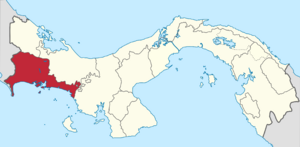Chiriquí Province facts for kids
Chiriquí is a beautiful province located in the western part of the Republic of Panama. It's known for its amazing natural beauty, from tall mountains to sunny beaches. The capital city of Chiriquí is David, which is a busy and important center for the region. In 2010, about 409,821 people called Chiriquí their home.
Contents
Exploring Chiriquí's Geography
Chiriquí has a very diverse landscape, meaning it has many different types of land.
Mountains and Volcanoes
The province is home to Panama's highest point, Barú Volcano. This volcano is inactive, so it's safe to visit. From its peak, you can sometimes see both the Pacific Ocean and the Caribbean Sea on a clear day! The mountain range here is called the Cordillera de Talamanca. It creates a cooler climate in the highlands.
Rivers and Coastlines
Many rivers flow through Chiriquí, like the Chiriquí Viejo River. These rivers are important for farming and provide fresh water. The province also has a long Pacific coastline with many islands and beautiful beaches. These areas are perfect for fishing and exploring marine life.
Nature and Wildlife in Chiriquí
Chiriquí is a paradise for nature lovers, with many protected areas.
National Parks and Reserves
- Barú Volcano National Park: This park protects the volcano and the cloud forests around it. It's home to many unique plants and animals.
- La Amistad International Park: Shared with Costa Rica, this huge park is a UNESCO World Heritage site. It has incredible biodiversity, meaning a wide variety of life.
- Gulf of Chiriquí National Marine Park: This park protects marine life, including coral reefs and islands. It's a great place for snorkeling and diving.
Amazing Animals
You can find many fascinating animals in Chiriquí. Some of them include:
- Colorful birds like the Resplendent Quetzal, famous for its long tail feathers.
- Monkeys, sloths, and jaguars in the dense forests.
- Sea turtles and many types of fish in the coastal waters.
Chiriquí's Rich Culture and People
The people of Chiriquí have a vibrant culture, blending traditions and modern life.
Indigenous Communities
Several indigenous groups live in Chiriquí, including the Ngäbe-Buglé people. They have their own unique languages, customs, and crafts. Their traditions are an important part of the province's heritage.
Local Traditions and Festivals
Chiriquí celebrates many festivals throughout the year. These events often feature:
- Traditional music and dances.
- Delicious local foods.
- Colorful parades and crafts.
The people are known for their hospitality and friendly nature.
Economy and Daily Life
The economy of Chiriquí is strong and diverse, supporting its communities.
Farming and Agriculture
Chiriquí is often called the "breadbasket of Panama" because it produces so much food. Farmers grow:
- Coffee in the highlands, especially in areas like Boquete.
- Fruits like bananas and oranges.
- Vegetables and other crops.
Cattle ranching is also a major activity in the lowlands.
Tourism and Adventure
Tourism is growing in Chiriquí. Visitors come to:
- Hike and explore the national parks.
- Enjoy white-water rafting on the rivers.
- Relax on the beautiful beaches and islands.
- Experience the cool climate and coffee farms in the mountains.
A Glimpse into Chiriquí's History
Chiriquí has a long and interesting history, dating back centuries.
Early Days
Before Europeans arrived, indigenous groups lived in the area for thousands of years. They developed complex societies and left behind ancient artifacts.
Becoming a Province
Chiriquí officially became a province of Panama in 1849. This was an important step in its development. Over time, it grew into the important region it is today, known for its agriculture and natural beauty.
Images for kids
See also
 In Spanish: Provincia de Chiriquí para niños
In Spanish: Provincia de Chiriquí para niños



